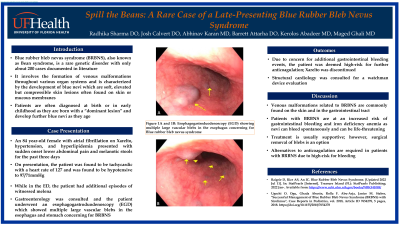Back


Poster Session C - Monday Afternoon
Category: GI Bleeding
C0334 - Spill the Beans: A Rare Case of Late-Presenting Bean Syndrome
Monday, October 24, 2022
3:00 PM – 5:00 PM ET
Location: Crown Ballroom

Has Audio
- RS
Radhika Sharma, DO
University of Florida College of Medicine
Jacksonville, FL
Presenting Author(s)
Radhika Sharma, DO, Abhinav Karan, MD, Joshua Calvert, DO, Barrett O. Attarha, DO, Kerolos Abadeer, MD, Maged P. Ghali, MD
University of Florida College of Medicine, Jacksonville, FL
Introduction: Blue rubber bleb nevus syndrome (BRBNS), also known as Bean syndrome, is a rare genetic disorder that involves formation of venous malformations throughout various organ systems. This syndrome is characterized by the development of blue nevi which appear as soft, elevated but compressible skin lesions often found on skin or mucous membranes. As mentioned, BRBNS is a rare condition with only about 200 cases documented in literature. Patients are often diagnosed at birth or in early childhood as they are born with a “dominant lesion” and develop further blue nevi as they age. We present a case of a late-presenting BRBNS in an 84 year-old female who was found to have gastrointestinal bleeding after starting anticoagulation.
Case Description/Methods: An 84 year-old female with past medical history of atrial fibrillation on Xarelto (CHADsVASc 5), hypertension, and hyperlipidemia presented to the emergency department with sudden onset lower abdominal pain and melanotic stools for the past three days. She denied any associated nausea, vomiting, diarrhea, lightheadedness, or hematochezia. She admitted to two dark bowel movements daily since the start of her symptoms. On presentation, the patient was found to be tachycardic with a heart rate of 127 and hypotensive to 97/71mmHg with improvement in both with fluid resuscitation. The patient had two additional episodes of melena while in the ED, however her hemoglobin remained greater than 7g/dL and she did not require any transfusion of blood products. Gastroenterology was consulted and the patient underwent an esophagogastroduodenoscopy (EGD) which showed multiple large vascular blebs in the esophagus and stomach concerning for BRBNS. Due to concern for additional gastrointestinal bleeding events, the patient was deemed high-risk for further anticoagulation and Xarelto was discontinued. Structural cardiology was consulted for a watchman device evaluation.
Discussion: Venous malformations related to BRBNS are commonly found on the skin and in the gastrointestinal tract. Patients with BRBNS are at an increased risk of gastrointestinal bleeding and iron deficiency anemia as nevi can bleed spontaneously and can be life-threatening. Alternatives to anticoagulation are required in patients with BRBNS due to high-risk for bleeding. Unless bleeding is severe enough where multiple blood transfusions are required, treatment is usually supportive; however, surgical removal of blebs is an option.

Disclosures:
Radhika Sharma, DO, Abhinav Karan, MD, Joshua Calvert, DO, Barrett O. Attarha, DO, Kerolos Abadeer, MD, Maged P. Ghali, MD. C0334 - Spill the Beans: A Rare Case of Late-Presenting Bean Syndrome, ACG 2022 Annual Scientific Meeting Abstracts. Charlotte, NC: American College of Gastroenterology.
University of Florida College of Medicine, Jacksonville, FL
Introduction: Blue rubber bleb nevus syndrome (BRBNS), also known as Bean syndrome, is a rare genetic disorder that involves formation of venous malformations throughout various organ systems. This syndrome is characterized by the development of blue nevi which appear as soft, elevated but compressible skin lesions often found on skin or mucous membranes. As mentioned, BRBNS is a rare condition with only about 200 cases documented in literature. Patients are often diagnosed at birth or in early childhood as they are born with a “dominant lesion” and develop further blue nevi as they age. We present a case of a late-presenting BRBNS in an 84 year-old female who was found to have gastrointestinal bleeding after starting anticoagulation.
Case Description/Methods: An 84 year-old female with past medical history of atrial fibrillation on Xarelto (CHADsVASc 5), hypertension, and hyperlipidemia presented to the emergency department with sudden onset lower abdominal pain and melanotic stools for the past three days. She denied any associated nausea, vomiting, diarrhea, lightheadedness, or hematochezia. She admitted to two dark bowel movements daily since the start of her symptoms. On presentation, the patient was found to be tachycardic with a heart rate of 127 and hypotensive to 97/71mmHg with improvement in both with fluid resuscitation. The patient had two additional episodes of melena while in the ED, however her hemoglobin remained greater than 7g/dL and she did not require any transfusion of blood products. Gastroenterology was consulted and the patient underwent an esophagogastroduodenoscopy (EGD) which showed multiple large vascular blebs in the esophagus and stomach concerning for BRBNS. Due to concern for additional gastrointestinal bleeding events, the patient was deemed high-risk for further anticoagulation and Xarelto was discontinued. Structural cardiology was consulted for a watchman device evaluation.
Discussion: Venous malformations related to BRBNS are commonly found on the skin and in the gastrointestinal tract. Patients with BRBNS are at an increased risk of gastrointestinal bleeding and iron deficiency anemia as nevi can bleed spontaneously and can be life-threatening. Alternatives to anticoagulation are required in patients with BRBNS due to high-risk for bleeding. Unless bleeding is severe enough where multiple blood transfusions are required, treatment is usually supportive; however, surgical removal of blebs is an option.

Figure: Figure 1A and 1B: Esophagogastroduodenoscopy (EGD) showing multiple large vascular blebs with a patchy distribution in the entire esophagus concerning for Blue rubber bleb nevus syndrome (aka Bean Syndrome).
Disclosures:
Radhika Sharma indicated no relevant financial relationships.
Abhinav Karan indicated no relevant financial relationships.
Joshua Calvert indicated no relevant financial relationships.
Barrett Attarha indicated no relevant financial relationships.
Kerolos Abadeer indicated no relevant financial relationships.
Maged Ghali indicated no relevant financial relationships.
Radhika Sharma, DO, Abhinav Karan, MD, Joshua Calvert, DO, Barrett O. Attarha, DO, Kerolos Abadeer, MD, Maged P. Ghali, MD. C0334 - Spill the Beans: A Rare Case of Late-Presenting Bean Syndrome, ACG 2022 Annual Scientific Meeting Abstracts. Charlotte, NC: American College of Gastroenterology.
